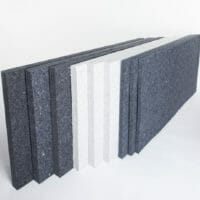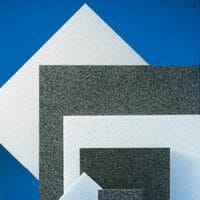Top 5 Methods of Control and Reduction of Excess Sound
Whether your classroom is next door to a train station or a highway with blaring traffic noise, there’s an ongoing construction project next door to your retail space, you may be looking for methods of control and reduction of excessive sound.
Reduction techniques can be as simple as adding “fluffy” items to your space or as complex as installing specialty sheetrock. In this guide, we’re covering the full spectrum—from DIY noise reduction methods to specialty acoustical products. When it comes to unwanted noise reduction, we’ll break down the difference between soundproofing and sound absorbing to help you set realistic expectations for your project.
Whether you’re trying to add soundproofing measures to your new construction project or find ways to manage sound leakage in an existing space, these five solutions could help you cut through the noise and improve sound control in buildings.
Soundproofing vs. Sound Absorbing: What’s Your Goal?
Before we break down some sound level and noise reduction techniques, let’s clarify the difference between soundproofing vs sound absorbing:
- Soundproofing methods prevent noise from penetrating (or escaping from) a space. Sealing up doors and windows, for example, can help soundproof a room.
- Sound absorbing measures help muffle the sounds that are already inside a space. Laying down a rug or hanging acoustical panels are two popular sound absorption tactics.
While it’s possible to completely soundproof a room, that isn’t always a practical goal—especially for existing structures. Before you employ any of the noise reduction methods below, determine which types of noise you’re trying to tackle (whether that be the sound level from outside or any noises already inside) and set realistic expectations.
Two Sound Absorption Methods
When it comes to reducing noise, try the following tactics to absorb sounds already inside of a space (like echoes––learn more about echo reduction for your space).
#1 Install DIY Sound Absorbing Media
Sound absorption is a generally DIY-friendly task. Since porous, soft materials absorb sound, consider adding some to your space to cut down on existing noise. Try adding:
- Stuffed furniture, like:
- Padded office chairs
- Cushioned armchairs and sofas
- Beanbag chairs or floor cushions
- Throw pillows
- Thick rugs (and rug pads)
- Thick noise reduction curtains
- Wall coverings, like tapestries or moving blankets
If an item is fabric-based or stuffed with batting, it could absorb some of the sounds bouncing around in your space—especially if you have brick walls (which, due to their density and thickness, don’t absorb sound very well).
#2 Install Specialty Acoustical Materials
Perhaps you don’t have room for more furniture or some of the DIY solutions above simply don’t work for your space—it’s not very practical to lay down a rug or hang curtains in a commercial kitchen, for instance.
When DIY solutions aren’t enough (or when they’re impractical), consider specialty acoustical materials from our collection like:
Perhaps you don’t have room for more furniture or some of the DIY solutions above simply don’t work for your space—it’s not very practical to lay down a rug or hang curtains in a commercial kitchen, for instance.
When DIY solutions aren’t enough (or when they’re impractical), consider specialty acoustical materials from our collection like:
#1 Install Insulation
If you’re working on a new construction project, consider installing an insulation product—like cellulose insulation panels—to help reduce the noise level outside or keep inside noises from escaping to the outside. Adding any amount of insulation will provide some sound control benefits.1 However, specialty soundproofing or absorption insulation products will always achieve better acoustics.
There are two important things to note about installing insulation:
- Insulation installation is simplest with new construction projects. Since most soundproofing insulation products are sold in panel or batt form, they’re hard to install in spaces with existing drywall.
- Insulation doesn’t block sound—it’s not dense enough. But, it can absorb some sound as it passes through your walls, reducing the overall noise penetration (or leakage) in a room.
#2 Use Soundproofing Drywall
Soundproofing drywall is an excellent product choice for new construction projects or substantial renovations.
Acoustical drywall is distinct from ordinary sheetrock in that it generally includes two distinct layers of gypsum sandwiching a layer of soundproofing material (commonly comprising a sheet or glue).
In sound absorbing applications, you’ll want to use puffy, absorbent materials. But, in soundproofing projects, you’ll need dense and thick materials to block excessive noise penetration or leakage. For the latter, soundproof drywall provides superior performance over normal, single-layer gypsum products.
#3 Seal Noise Leaks
If you can only make limited modifications to your space, or if you’re working on a tight budget, specialty insulation and drywall might not be the most practical noise reduction methods.
But, you can still take smaller-scale soundproofing measures—like sealing doors and windows—to eliminate some hazardous noise. Consider:
- Filling cracks in floors, bricks, or grout/mortar with a sound-dampening compound
- Installing door seal or window seal kits
- Installing traditional sealing products like plastic door sweeps or foam weather stripping
While these may not be as robust as soundproofing insulation or drywall, they can still help reduce some of the noise pollution and noise exposure in your space.
Expert Noise Reduction Methods from Acoustical Surfaces
These methods of control and reduction of excessive sound can help you block out or absorb bothersome sounds in your space and provide hearing protection. But if your budget is tight or your project is complex, turn to acoustical experts for support.
At Acoustical Surfaces, we have the expertise and the quality products to help you achieve your sound reduction goals. No project is too big or too small—whether you’re curious about how to soundproof a metal building, reduce restaurant noise, or fine-tune the acoustics in an entertainment venue, we’re here to help you create crystal-clear soundscapes.
If you’re ready to tackle excessive noise control for good, contact our team today.
Sources:
- Berndt Zeitler. Chapter 2.3 – Influence of internal thermal insulation on the sound insulation of walls. https://www.sciencedirect.com/science/article/pii/B9780128165133000083







